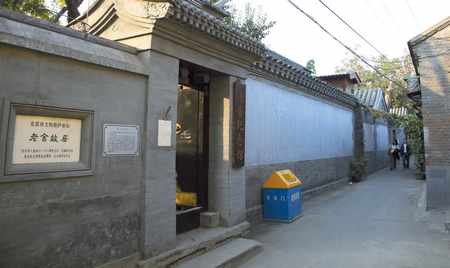Big names, small lane: it's Fengfu Hutong
|
|
|
Lao She Musuem. Photo: CFP |
At first glance, this hutong near Wangfujing Main Street may not look like much - quite literally. At less than four meters wide, Fengfu Hutong is in stark contrast to the six-lane boulevards that characterize much of Beijing. Yet this little street has a big personality and has been home to some of the most famous names in Chinese history.
Take No. 19, for instance, the former residence of writer Lao She, and now a museum in his memory. In 1949, at the invitation of premier Zhou Enlai, Lao She gave up his comfortable life in America and returned to a war-ravaged China. As a hutong-born writer (see A place with no memory: Xiaoyangjia Hutong, February 8) he spent the next 16 years comfortably living in Fengfu in what was then known as No 10.
The babysitter's dead…
Actually, Fengfu itself used to be called Fengsheng but confusion with another hutong of the same name in Xicheng district led to the name being changed in the 60s to avoid further mix-ups. However, the name Fengsheng has an interesting back story. The area, formerly known as Nai Zi Fu, was the official home for wet nurses prior to their moving to the imperial palace. In feudal China, concubines or empresses left their children to be suckled by other new mothers, a wretched existence generally but with a potentially great future for a lucky few.
One such woman was Ke Shi, who looked after Ming Emperor Zhu Youxiao. When he ascended to the throne, the former nanny joined his ascendancy, eventually reaching the rank of Feng Sheng Fu Ren (Emperor's Servant Madam) and her original home was named after her. While things didn't end so well for Ke - her monopoly of power led to the former babysitter being executed after Zhu died - the name of the hutong remained.
Museum's inconspicuous
Ke may have bestowed the legal name, but it was Lao She who added the alley's cultural heritage. His house-turned-museum, bought back in the 50s for the princely sum of 500 dollars, is not exactly notable looking nowadays. A shabby door and a note saying "Lao She Museum" give the game reluctantly away that this old siheyuan was where Lao She divided his time between work and play - the courtyard house was divided into three; family, study and private time with the wife.
"Lao She felt passion and commitment with ordinary lives," remarks Zhang Wensheng, director of the Lao She Museum. No. 19 is certainly ordinary looking. But in literary terms, extraordinary things happened there. "All of his great works, such as Teahouse were written here," Zhang tells us. In 1966, Lao She is said to have "committed suicide" during the Cultural Revolution, leaving his great work Under a Red Banner unfinished. A creature of habit, the calendar on his desk is still open to the page from the day he died.
Today, you can check out the original look of No. 19. The two persimmon trees Lao She planted are still flourishing with red fruits each year, fitting the name "Dan Shi Xiao Yuan" (Red Fruit Courtyard) his wife gave it, even half a century and seemingly a whole world away today.
 0
0 









Go to Forum >>0 Comments